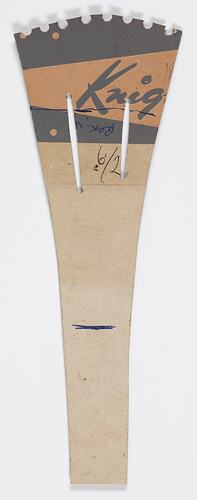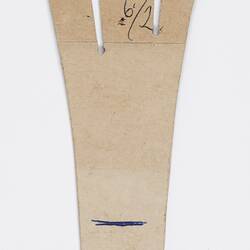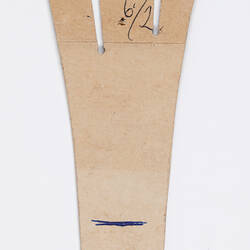Summary
This grey coloured fan shaped conical form with its two slits was most likely the pattern that Stanio Fancoff used when making vamp embellishments for his women's basketweave shoes sometime between the 1930s and 1970s. Along with many others, this pattern was an integral part of Stanio's shoemaking craft and business.
Stanio Ivanoff Fancoff was born in 1908 in Bojentsi, a small village in Bulgaria. At age 11, Stanio left home to learn the shoemaking trade. In 1929, he immigrated to Melbourne, settled in Fitzroy and began to work for the V.G. Zemancheff & Sons basket shoe factory in South Melbourne. In1936, he married Dorotea Georgi Touzou who had recently arrived in Australia. Around this time, Stanio set up his own shoemaking business from home, with Georgi, her cousin and sister weaving the shoes which he then assembled. Select shoe samples were then taken to Sydney and Tasmania for sale. In 1942, Georgi and Stanio moved to Broken Hill for Georgi's health; there daughter Nancy was born and Stanio set up a shoe shop/factory. In 1945, Georgi died and by 1950 Stanio and Nancy had moved to Adelaide where he again opened a shoemaking business and shop. He passed away in 1978, having been in the shoemaking business for 59 years. This collection documents his migration and working life experiences.
Physical Description
Grey cardboard shaped within a fan shaped cut-off conical form. Encompassing all outer edges are the remnant pencil cutout lines. Top edgeline displays half hole-punch marks referencing ornate pattern. Central upper region has a pinhole puncture flanked by two elongated cutout slits; the right measures 4cm in length and the left 3cm. Inset approximately 2mm from the left cutout slit's top and base points are two (one on each end) singular horizontal pen lines that intersect and cross over the cutout. Located at the lower third mark point a pencil line runs horizontal across the pattern's width. The reverse is a brown, orange and cream matt commercial surface complete with text. Although in good condition, there is a fold mark at the upper thirdway point.
Significance
This collection is significant in documenting a small migrant business as well as the fashion of a particular period. It is well provenanced and charts the application of trade skills in a new country. It also illustrates the stages of hand shoe manufacture from the 1930s, demonstrating the enduring nature of the tools and patterns that were used.
More Information
-
Collecting Areas
-
Acquisition Information
Donation from Nancy Vasileff, 21 Mar 2007
-
Maker
-
Inscriptions
Commercial, Brown Cursive Script, Text: Knig Handwritten, Blue Ink, Text: Bok / 6/2
-
Classification
-
Category
-
Discipline
-
Type of item
-
Overall Dimensions
66 mm (Width), 184 mm (Height)
-
References
R.A. Salaman, 'Dictionary of Leather-working Tools c.1700-1950 and Tools of Allied Trades,' London: George Allen and Unwin (Publishers) Ltd, 1986 [Section 2: Boot and Shoe Maker pp18-185]. John Peacock. 'Shoes, The Complete Sourcebook,' London:Thames & Hudson Ltd, 2005. NAA holds file (online) on Vasil George Zemancheff, Fancoff's employer
-
Keywords
Boot & Shoemaking, Bulgarian Communities, Bulgarian Immigration, Immigration, Small Businesses



